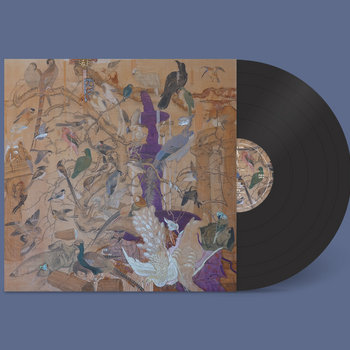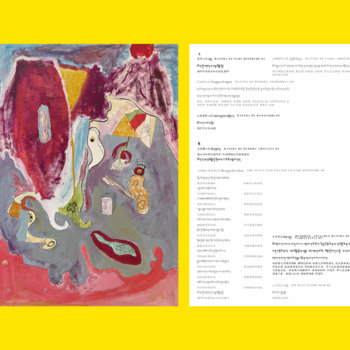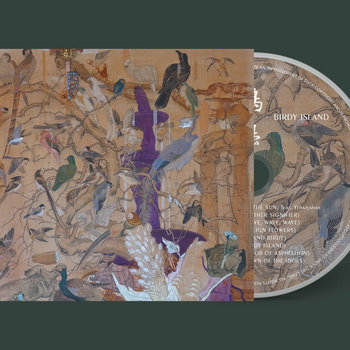 Photos by Lyuo
Photos by Lyuo
“I hope you listen to my music, and feel like we have been there together,” says Beijing-based multi-disciplinary artist and producer Howie Lee.
“There” is the Buddhist Monastery in northeastern Tibet where Lee spent two weeks recording his new album, and he doesn’t mean his words in a “close your eyes and let yourself be transported to Tibet” kind of way. He means that the music will take you there—literally. According to Tibetan Vajrayana Buddhism, the boundaries between self and other, subject and object, are illusory; the mind is not separate from the external world. “For the Buddhist ideology, having the idea creates the reality,” says Lee. “So if you create the idea itself, you have already been there.”
Before he began working on his latest album, At The Drolma Wesel-Ling Monastery, Lee considered himself a “Buddhism outsider.” He understood it in principle, but didn’t feel any true connection to it. “The extraordinary thing is that I thought I understood how it worked,” he says. “But it has a very different meaning as you follow the path, and practice what you know. I feel like after these one or two years of practicing, I have a much better understanding of the world, and of myself.”








2 x Vinyl LP, Vinyl LP




As one of the biggest names in the Chinese electronic music scene and the founder of Do Hits—a club night that grew into a popular local label—Lee has played a major role in shaping the sound of Chinese club music. His discography has often been inspired by Chinese history, and many of his albums are closely entwined with whichever broad social and cultural questions have his attention at that particular moment. 2021’s Birdy Island was set in a dystopian future following society’s collapse under capitalism; 2020’s 7 Weapons Series is loosely based around the martial arts stories of novelist Gu Long, and explores the idea of sampling and what it means to give sounds new meaning in a different context; On Tiān Dì Bù Rén from 2019, he explored the Taoist concept that sees nature as indifferent to the destiny of humanity, and reflected on the connection between capitalist greed and environmental degradation; His Socialism Core Value EP series gives socialist anthems, 1980s pop hits, and old folk songs a club-focused rework, recontextualizing a slice of nostalgia that was so specific to its time.
In his previous work, Lee decided on the specific theme he wanted to explore from the outset. His encounter with Buddhism, and the role it played in At The Drolma Wesel-Ling Monastery, happened almost by accident. “It was 2022, the last year of this crazy pandemic,” Lee recalls, “and while Europe was starting to open up, China was facing its weirdest lockdown year yet.” With all the uncertainty came a certain degree of freedom. After dropping off his wife, an artist and DJ who performs under the name Veeeky, at the airport for her European tour, Lee started driving West with little to no plan. “I drove 20 hours to get to Chengdu, West China,” he says. “I had no goal, nothing lined up in my future, so I thought I’ll just drive and see. It was all random, you know?”


Along the way he stopped to visit a friend, the experimental musician and youth cultural researcher Zafka. “He is a Buddhist so we talked a lot about Buddhism,” Lee says. “At that time, I didn’t have much experience, but I was learning a lot from him.” It was while he was there that Lee received a call from a Tibetan friend, photographer and designer Nyema, who at the time was working on a project at a Buddhist monastery far away in the mountains of Southern Qinghai Province, bordering north-eastern Tibet’s Karub District. “I thought, ‘OK, this is the perfect time,’” recalls Lee. He and Zafka set off for a weeklong drive to the Drolma Wesel-Ling Monastery, which sits amidst a vast green expanse at 4400m of altitude.
The monastery was established in 1988 by Tuga Rinpoche, a respected local doctor hailing from a prominent family lineage of “Rinpoche.” (The name translates as “precious master,” indicating a living or reincarnated Buddha.) The monastery teaches meditation and monastic studies to 300 nuns and around 100 monks in the Nyingma tradition of Tibetan Buddhism, which is the oldest of the four main schools. Tuga Rinpoche, an amateur musician and music enthusiast, built a recording studio in the nun’s section of the monastery to facilitate training in chanting, a central practice of Tibetan Buddhism.


Vinyl LP, Compact Disc (CD)


Lee had access to an extensive sample library, but he also spent time recording and jamming. “I was with the monks and nuns during their group chanting classes, and I played my music with them,” Lee says. “The monks were very excited, and you could tell they were kind of running with the music. The nuns I think are more shy, but also curious. Jamming was the most interesting thing to me.”
Across the album, Lee combines the low, powerful hum of the monks’ devotional chanting with blistering hyper rhythms, bone-rattling bass, and samples of traditional Chinese and Tibetan instrumentation. Rather than sounding like a collage of different worlds, these age-old mantras, and Lee’s typically experimental club-futurism, all come together into a cohesive, transcendental whole, reflecting the Buddhist concept which understands time as relative and ultimately illusionary. The mantras, says Lee, “represent the past, present, and future.”
“Mantra of Guru Rinpoche 莲师心咒,” a tribute to the tantric master from medieval India who first brought Buddhism to Tibet in the 8th or 9th century, opens the album with an ominous siren call and the resonant thud of a Chinese bass drum. Like a levee breaking, the expectant atmosphere is soon flooded with knife-edged synths and Lee’s jagged, fast-paced rhythms, which are perfectly matched by the monk’s deep, calm mantra intonations. “When you sing these mantras, they create a vibration—that’s why in Tibet they call it a Lion’s Roar,” says Lee, referring to the abdominal resonance of the voices in unison during the daily collective chanting. “Some Mongolian musicians use a similar technique, but that’s more in the throat. Here, it’s lower in the belly.”
On “Mantra Of Buddha Akshobhya 不动佛心咒,” based on a mantra that’s meant to clear negative karma, a nun’s steadily flowing vocal powers through a rich canopy of organic percussion and a base of intricate, skittering footwork rhythms. Lee works more rapid drum patterns into “The Seven Line Prayer To Guru Rinpoche 莲师七句祈请文,” this time under an unforgiving barrage of harsh, abrasive synths.
He uses a host of traditional instruments throughout, such as the yangqin, a Chinese hammered dulcimer, on “Mantra of Vajra Armour 防瘟疫咒,” one of the most transportive tracks on the album; or the digitized northern Indian harmonium on “Hundred – Syllable Mantra Of Vajrasattva 百字明,” weaving them into global dance genres such as Brazilian funk or the dubstep and UK garage on the dreamy “Mantra Of Buddha Amitayus长寿佛心咒.”






2 x Vinyl LP, Vinyl LP




But the heart and soul of the album are the ancient mantras, repeated day in day out by the monks and nuns of Drolma Wesel-Ling Monastery. “Before even starting, I had to go and study this material, and understand what it is,” says Lee. “They were confusing me at first, because they were originally from India and it’s a language we don’t know. But each one of the mantras has a specific functionality.” The “Mantra of Vajra Armour 防瘟疫咒” is said to treat diseases and ward off negative energies, and was often sung by the inhabitants of the monastery during the pandemic; “Om Mani Padme Hum六字真言” is one of the most widely recognized mantras in Tibetan and Chinese Buddhism and is primarily used for cultivating compassion, wisdom, and spiritual growth.
“I have this idea of mantras, that they are a connection between us and all other creatures, or even between us and other things that we don’t consider to be alive, like mountains,” says Lee. Traditionally, mantras are composed of specific syllables which are believed to have profound spiritual significance. By resonating through the body and the environment, these chants are believed to reflect and simultaneously reinforce the interconnectedness of all beings. “It’s not random at all, it’s like sheet music, just like Beethoven,” says Lee. “It’s sheet music written by people who knew that in the future people would still be singing them, so you don’t need to understand the language to understand it. I found it so interesting—way more interesting than the music I produce.”

Much of Lee’s discography weaves together elements of traditional music with his bass-heavy club production, but on At The Drolma Wesel-Ling Monastery he harnesses the hypnotic power of the mantras and club music at its most visceral to create the kind of dance music that strikes deep. Which is especially notable given that, in recent years, Lee had taken a step back from the club world. “Before the pandemic, I felt that the DJ world was too loud for me,” Lee says. “I had this issue about being surrounded by alcohol, and staying up too late. That was becoming a big problem for me.” It was during this “quieter” time that he began working on 2021’s Birdy Island, his lushest, most acoustic album to date. The record is set in an imagined future where, in the aftermath of an economic collapse and prolonged environmental deterioration, the Earth’s ecosystems have been profoundly damaged. “Birdy Island”—partially inspired by an imaginary version of Sicily that Lee dreamed up after listening to its folk songs—is a floating theme park built by a Chinese investment company in an effort to rebuild the relationship between humans and nature and, according to the concept that drives the album, Lee has been asked to compose the park’s soundtrack.
With its ambient soundscapes and mostly acoustic instrumentation, both subtly filtered through Lee’s electronic production, Birdy Island seemed to signal a new era for the artist. “I was just interested in doing this quieter music, electronic music that sounded acoustic,” he remembers. Perversely, it was the pandemic that led him back to the club: “There was a lot of demand [when lockdown lifted] and it was also very fun,” Lee recalls. “You could throw a party and without promoting it and 1000 people would come, because no one knew what would happen in the future. And for the first time the different scenes—electronic, hip-hop, rock—were all connected. Because of this experience working in the DJ booth during the pandemic, I somehow decided to make a more dancefloor accessible album [with At The Drolma Wesel-Ling Monastery].”
Lee’s approach to both listening and music making has been guided by a profound curiosity about the world around him. Each album feels almost like a by-product of his inquiries and exploration into one topic or the other, which he then passes along for the world to enjoy and reflect upon. “I’m always on something new,” he says. “[Once an album is released] my part has finished so I go away, and usually when it comes out I’m already working on something new.”
Right now, he is working on an album that explores the use of AI, using prompts and changing his voice in different ways. While the rest of the world is worrying about the impact AI is going to have in the future, Lee is leaning into it and exploring all of its possibilities: “I just think I have to adapt to the environment I have now,” he says. “I just play with it because I predict a very interesting future with AI.” It is just one more world for Howie Lee to discover.







